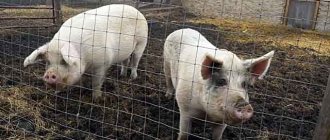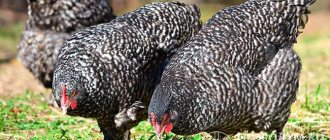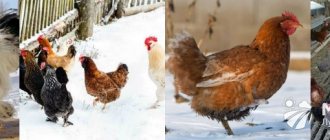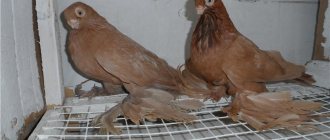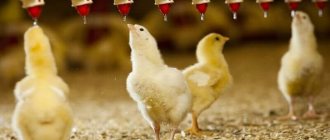Village residents quite often raise chickens. Residents of megacities are also showing interest in this, as the popularity of environmentally friendly products is increasing every day. And I would like to note that raising laying hens as a business can be easily mastered by both rural and urban residents. And to do this, you need to create a business plan for breeding laying hens and decide whether this activity is really profitable.
Why is it profitable to raise laying hens?
Breeding laying hens as a business can bring the owner stable and good profits. This fact is explained by the constant demand for eggs among ordinary buyers, as well as among food producing organizations.
Eggs are considered an essential source of protein and amino acids for adults and children. They can be an independent food product or used for preparing other dishes, in particular confectionery. For this reason, the chicken business allows you to obtain in-demand products.
Not all chicken breeds are suitable for producing eggs on a scale sufficient for sale.
Business registration
If in the future you plan to expand your business and increase the number of birds, it is worth registering your business as a peasant farm (KFK) or obtaining the status of an individual entrepreneur. This will require assembling a minimum package of documents - an application for registration of a peasant farm, an agreement on the creation of a peasant farm, a receipt for payment of state duty, a copy of the passport, an application for the transition to a special tax regime. The tax will be about 6% , but will significantly simplify the further process of obtaining product certificates. You will also need permission from the fire department and documents from veterinarians.
Chicken farm: nuances of opening from business registration to purchasing birds and calculating profitability
Read
How to properly organize a broiler business? Is this activity profitable and what needs to be taken into account?
More details
Top 10 most productive egg breeds and crosses for breeding. Factors to consider when choosing poultry for the farm
Look
What features of laying hens you need to know
Beginning poultry breeders and farmers should be aware that not all breeds of chicken are suitable for producing eggs on a scale sufficient for sale. There are special breeds that have been artificially bred to increase egg production.
Such hens lay eggs early (from 5 months) and produce 2 times more eggs: up to 300 per year versus a maximum of 180 in conventional breeds. At the same time, their eggs are whiter and larger. They are “fertile”, but are significantly inferior in other characteristics - they gain weight poorly (the optimal weight of such a chicken is 1.9 kilograms) and are less beautiful.
The weight of individuals has nothing to do with their fertility. Also, laying hens do not hatch eggs, so it will not be possible to increase the population naturally. To increase the number of birds, you will have to either hatch chickens in an incubator or purchase them from breeders.
Sales of products
Chicken eggs are consumed in every family; this product is not seasonal. Is there a demand and what are the ways of implementation? It’s worth finding out before starting a business with chickens.
Sales channels
There are several ways to sell chicken eggs:
- Outbound sales from a vehicle in certain locations.
- Reserve space in the market.
- Delivery to shops, supermarkets and cafes.
- Maintaining a website, taking orders by phone.
Is advertising necessary?
If people don't know, they won't buy. Therefore, advertising is needed. To begin with, it is worth establishing trade between neighbors and acquaintances, perhaps they will recommend it to someone else. If you have all the necessary documents, you can visit retail outlets and offer to display your goods on the counter, and to stimulate sales and attract the attention of buyers, order advertising posters from the printing house.
The best laying hens - breed rating
Of course, the fertility of chickens is directly related to the conditions of detention and especially the quality of food. But not the least important is the breed of bird and its characteristic egg production indicators. The following breeds are considered the best for egg production:
- Russian white chicken. Very egg-laying birds, in the first year of life they will produce 2 hundred white eggs weighing about 55 grams.
- "Hisex" are medium-sized chickens with brownish plumage. They are also very prolific, as they produce up to 300 eggs weighing up to 60 grams per year. There are several varieties that differ in color; the most productive is the “Hisex Brown” breed. White representatives of this breed produce slightly fewer eggs (up to 280 per year), but they are whiter and larger.
- "High Line". They easily adapt to different conditions and lay about 350 eggs annually.
- "Isa Brown." 320 brown eggs annually, while individuals easily acclimatize and begin laying eggs after a maximum of 4.5 months.
- "Leggorn." A feature of the breed is high fertility in the first year of life with its subsequent decrease. In the first year, a Leghorn chicken will lay 360 eggs, but then this figure will inevitably decrease even under good housing conditions.
- "Loman-brown", 320 eggs annually during the active period (about 2 years).
- "Tetra". Chickens with early fertility (from 21 weeks), but fertility rates are slightly lower than previous breeds - no more than 250 per year. The Tetra SL variety is more egg-laying - 310 eggs.
- Kuchin anniversary chicken. This breed of chicken is already considered suitable for both eggs and meat. Individuals grow up to 2-3 kilograms, and the meat is considered more nutritious than broiler meat. Their figure is 220 eggs annually.
- Shaver cross. They lay up to 320 eggs per year, with peak fertility occurring after 25 weeks of development.
Of course, quite often the chicken business uses other breeds:
- Minor chickens (about 160 eggs);
- Rhode Island (no more than 200);
- New Hampshire (no more than 200);
- Gamburskaya (from 140 to 180);
- Ukrainian earflaps (no more than 200);
- Orlovskaya (about 150);
- Pavlovskaya (120 eggs);
- Pushkin striped-motley (about 200 eggs).
However, these breeds are inferior to those mentioned above in terms of fertility, which means they promise the entrepreneur less profit. It is also important to pay attention to this fact: according to the observation of farmers, laying hens are more fertile in the area in which they were born. Therefore, if you plan to import livestock from another region, pay attention to those breeds that tolerate acclimatization well.
According to the observation of farmers, laying hens are more fertile in the area in which they were born.
Brief information about chickens
Chickens are the most common type of poultry. They are bred for eggs and meat, less often for feathers and down. This type of bird is the most productive. There are several groups of breeds:
- egg;
- general use;
- meat breeds.
Important! Before choosing a breed of chickens, you need to decide on the purpose of breeding them.
Chickens
How long does a laying hen live?
The maximum fertile period of a laying hen occurs in the first year of life: it is between reaching maturity and before reaching one year that the hen will lay the most eggs. Then the indicators will steadily fall, even with good nutrition and maintenance.
For comparison, when breeding chickens for slaughter, the lifespan of individuals is several times shorter - about 10 weeks, more precisely until they gain optimal weight. In commercial farms, laying hens live for 1-2 years, in private farms - about 3 years.
Reviews
Reviews about the chicken business are mostly positive. Chicken is a typical and unpretentious bird for our latitudes. And the field of activity here is quite wide: you can keep chickens for eggs, you can get meat from them, and it is no less profitable to sell young animals or eggs for breeding. Profit will not be long in coming if you are inspired by this business and approach it consciously and prepared. Under optimal conditions, you can reach 100% profitability within 8-12 months of activity.
Where to buy birds for breeding and how much you have to pay
Currently, there are many offers on the market for laying birds that promise at least 320 eggs per year. You definitely shouldn’t believe them all. Do not buy livestock from unverified sellers. The most competent option would be to purchase individuals from a poultry farm - there they will give you guarantees of the health of the birds, as well as useful recommendations regarding maintenance.
Buying “from hand” or at the “bird market” risks purchasing low-fertility or sick birds, which will only bring you losses.
Before purchasing, be sure to read reviews about the seller and basic information about him.
Also, before purchasing, be sure to read background information about the breed you are purchasing: not only egg production and weight indicators, but also living conditions, useful recommendations regarding nutrition and disease prevention.
Prices for birds depend on the seller, region of purchase and breed. On average, the price of a bird (adult, about 4 months old) starts from 450 rubles and can reach up to 10 thousand rubles. How many chickens should you buy? The answer depends solely on the capabilities of the farm.
Purchase of young animals
So, you have decided on the breed and it’s time to buy birds. You can buy chickens, but experienced breeders recommend purchasing adult chickens.
If you decide to raise birds yourself, starting from the first day of life, you should consider the following disadvantages:
- inability to determine the sex of a chick;
- increased risk of mortality and disease;
- higher maintenance costs , because in the first 10 days of life, chickens need careful care.
The advantage is the low price for day-old chicks.
Buying week-old chicks has fewer negative aspects - older chicks are more independent, have a higher survival rate, and can eat coarse feed. However, they cost more and still need more attention.
Buying five-month-old chickens is the most profitable: you know the sex of the bird (for 10 hens you need 1 rooster), the likelihood of sudden death is very low, and care is simplified.
Birds should be purchased from poultry farms, because when buying chickens in markets, there is a chance to end up with an unscrupulous seller, and the risk of purchasing sick or unvaccinated birds increases.
How to distinguish young broilers from regular chickens?
Read
Cockerel or hen: how to distinguish the sex of a chicken at different ages based on external signs and habits?
More details
How to properly transfer chickens to a common chicken coop? Age of relocation and ways to eliminate possible conflicts
Look
In what conditions should laying hens be kept - a free enclosure?
Is it profitable to keep laying hens? These birds are quite unpretentious, so keeping them is quite a profitable business. To keep birds year-round you need:
- warm room (for the cold season);
- walking area.
Free keeping is considered more preferable , as it gives the birds the opportunity to walk and feel free. The livestock spends the night in the chicken coop, and during the day is where it is more comfortable - either also indoors in the chicken coop, or in an open-air enclosure.
A chicken coop is a room for birds where they will lay eggs. The fertility of birds depends on how well it is organized. In principle, this is not difficult: birds need a perch, a feeder, a drinking bowl, and a ladder between the levels of the perch. The chicken coop should be covered, warm and draft-free.
The best material for a perch is wood. It needs to be installed at a height of 60-70 centimeters. It should be comfortable for chickens to hold onto it with their paws. The length of the perch is determined by the number of birds: one individual needs about 30 centimeters for comfortable placement. At the same time, in winter the chickens sit more closely (for warmth), and in the summer, on the contrary, they sit more spaciously.
The enclosure can be covered, but this is not necessary. Chickens fly poorly and even a small barrier becomes a significant obstacle for them. In this case, it is important to make a rain shelter or provide constant access to the chicken coop so that in case of bad weather the birds can hide. There should be no poisonous plants growing in the aviary that can harm the birds - they will definitely taste them.
Chickens fly poorly and even a small barrier becomes a significant obstacle for them.
Keeping livestock in cages - what are the advantages?
However, another option is also possible - permanently keeping birds in cages. This method is considered even more profitable, since chickens lay eggs better in cages and gain weight faster. By the way, it is not worth combining housing options , since birds get used to certain conditions, and changing them causes stress, or rather, has a bad effect on weight and egg production.
When keeping in cages, up to 8 birds are placed in cages per 1 square meter of room. If the population is large, the cages are placed in tiers. Of course, funds will also have to be allocated for the purchase of cells and their installation.
Choosing a poultry keeping method
Actually there are only two ways:
- Cellular.
- Floor.
Each of them has its own pros and cons, as well as different funding for arranging comfortable conditions for laying hens.
- Cellular content . The method is quite expensive and takes time to implement. It will be necessary to assemble shelving, develop and install feeders and drinking systems. To prevent infectious diseases, the cells will need to be constantly cleaned. Each one, keep this in mind. With this method of keeping chickens, it is very important to comply with sanitary and hygienic standards. Even if you decide to make the cells yourself, the savings will be insignificant; you will still have to spend money on the material, and it is not cheap. In addition, laying hens constantly sitting in cages will have to be fed on combined feed, which is also not particularly economically profitable.
- Floor contents . More popular method. Unlike a cage, chickens will be able to walk in the surrounding area in the fresh air, and this is a huge plus for maintaining the productive performance and health of the bird. When raised outdoors, the bird’s diet can be enriched with vegetables, waste from its table, and in addition, the hen independently looks for pasture while walking around the walking area. The only disadvantage of this method is the need to have sufficient area.
We decide on the method of content and move on to the next point.
Layer hen nutrition: recommendations for fertile flocks
What do fertile laying hens eat? It is most convenient to make compound feed as the basis of the diet - it contains all the nutrients and vitamins that animals need. In addition to feed, birds eat any grain, including corn, home-grown vegetables (boiled potatoes, pumpkin), bone meal, flax and sunflower seeds, legumes (also boiled), cakes, meal, table salt. Sometimes 5-10 grams of yeast are added to the feed.
It is important to know that birds also feed on “inedible” foods: chalk, ash, fine gravel, eggshells, fine gravel and even shell chips. It is important to include grass in the diet of laying hens (up to 20% of the total diet) - dried or fresh meadow grasses, clover, alfalfa, lettuce, peas, dill. Stinging nettle can sometimes be given to birds. In the cold season, pine needles will be indispensable - they contain a lot of carotene and vitamin C.
If the owner prepares the bird’s diet independently, without the use of compound feed, it is important to add a sufficient amount of protein to it. Chickens are not herbivorous birds; they need animal protein. This role can be played by dairy products, meat and fish waste, including bone meal, and even earthworms.
Birds in any type of housing (cage or aviary) are fed 2-3 times a day: full feeding in the morning and evening, and mineral and vitamin supplements in the afternoon. The serving size per individual depends on the breed, but on average it is about 100-150 grams.
Under no circumstances should you feed your chickens spoiled food from your home table. Also, you should not give fresh bread to birds - it provokes intestinal problems. Rusks are much better. It is necessary to monitor the reaction of chickens to nutrition and their egg production, and, if necessary, adjust it. Overfeeding birds is extremely harmful - the quality of the eggs will decrease.
The main danger to the bird population is disease.
Registration of private household plots
If you are planning to raise poultry as a business on a personal or rented plot of land and do not want problems with the state, you should think about registering a personal subsidiary plot (LPH).
Private household plots mean non-entrepreneurial activities for the production and processing of agricultural products. All products manufactured by the owner are considered his property and can be sold. At the same time, only members of one family participate in private household plots. Non-relatives are only included if they live with you.
You can organize private household plots on your own or rented land if you have issued permits. You can keep animals and birds or grow vegetables immediately after obtaining the right to land, without registering private household plots as a legal entity.
Local government bodies are responsible for registering private household plots. Therefore, submit the following information to the administration of the locality to enter data about your private household plot in the household ledger:
- FULL NAME. and date of birth of the owner or tenant of the land plot, information about family members;
- Cadastral number of the plot and its area;
- Number of animals and/or poultry;
- List of agricultural machinery, equipment and vehicles.
After registering a private household plot, develop your business and legally sell your products. To do this, obtain a certificate from the administration stating that the goods were produced in private household plots. In this case, the proceeds are not subject to taxes and VAT, regular payment is only for land tax.
Main hazards for poultry farming
The main danger to the bird population is disease. Laying hens are threatened by several diseases at once, which can destroy half of the individuals, make the chicken coop and aviary unsuitable for keeping birds, and deprive the owner of profit. Among these diseases are:
- Typhoid or pullorosis. The first sign of this disease is a disorder of the digestive organs. Then the chickens become lethargic, lose weight and refuse to feed. This infection spreads quickly within the livestock through airborne droplets and can become chronic.
- To prevent this from happening, it is necessary to promptly test with a drug containing pullor antigen. Sick birds are isolated and treated with antibiotics. Prevention of the disease is constant monitoring of the condition of individuals and timely isolation of “suspicious” ones.
- Avian cholera or pasteurellosis. The disease is spread by a harmful microorganism, Pasteurella, which is spread by wild birds and rodents. With avian cholera, birds also become inactive, refuse to feed and drink a lot, mucous discharge appears from the nasal cavity, and the joints become swollen and distorted.
- Pasteurellosis is treated with sulfa drugs. It is beneficial for sick birds to eat grass and vitamin complexes. As a preventive measure, it is necessary to isolate from wild birds and rodents, and also completely limit access to food and water.
- Salmonellosis. Young livestock are most susceptible to this disease. Salmonella bacteria easily penetrate the shell, enter the feed and are transmitted from bird to bird. The most obvious signs of this disease are swollen eyelids and watery eyes, swollen limbs and difficulty breathing.
- The treatment is a 10-day course of furazolidone, which dissolves in water. After 10 days, the course is stopped for a week and then repeated again. There is a preventive serum against salmonellosis, so a good solution would be to carry out preventive courses several times a year.
Any avian disease is easier to prevent than to cure , since infections and bacteria are very quickly transmitted within the population. Monitor the quality of the birds' diet and the presence of sufficient vitamins in the diet. Chickens do not like drafts and cold. Keep them away from rodents. When the disease is detected, organize disinfection of all premises where birds are kept.
Time is money
Many newbies are intimidated by chicken coop care. It seems that you will have to spend half a day in the enclosure - clearing debris, cleaning perches, sweeping. In fact, a dozen chickens do not cause so many problems, and besides, bird waste is of great value as fertilizer. The main thing is to rationally organize the hens’ habitat, not to use the chicken coop as a warehouse for unnecessary things, and immediately create a routine for caring for the birds:
- In the morning, chickens need to pour feed and pour water, and also collect eggs (10 minutes);
- in the evening you should check the availability of water, feed again, and remove the droppings (10–15 minutes).
A place for walking should be organized right there - near the chicken coop. Be sure to fence it with a net so that the birds do not wander off, become victims of predators, and do not visit the beds.
How much profit will raising laying hens bring?
Now let’s look at what kind of profit is possible when breeding laying hens using the example of a medium-sized farm that simultaneously houses 100 healthy adult birds. The average productivity of one laying hen is 250-300 eggs, which means the entire flock will produce from 25,000 to 30,000 eggs per year.
A dozen large domestic eggs are sold at prices ranging from 60 to 100 rubles. This means that the sale of 30 thousand eggs will bring the owner from 180 thousand to 300 thousand rubles. This is a good indicator, but you need to subtract from it:
- costs for purchasing livestock (about 50 thousand rubles);
- food and maintenance costs (about 30 thousand rubles);
- related expenses, such as utility bills and transportation costs (depending on the volume of the farm).
Financial plan
A financial plan is necessary for detailed calculation of costs and profits. It will help you calculate the payback period of the project and the optimal number of chickens for stable business.
Start-up capital
In any business you have to invest your own money. In this case, their amount depends on the availability of a ready-made outbuilding, since the main amount of costs falls on construction and the purchase of equipment. Let's assume that the building is already available and you only need to purchase equipment and birds.
Approximate investment amounts are listed in the table.
| Attachments | Deadlines | Amount, rub. |
| Paperwork and registration | 1 month | 10000 |
| Ventilation, heating | 2 months | 5000 |
| Purchasing the necessary equipment | 1 Week | 30000 |
| Purchase of young animals/100 chickens | 1 Week | 40000 |
| Feed purchase/6 months | 1 Week | 26250 |
| Total | 111250 |
In this situation, the starting capital will be 111,250 rubles, not counting unforeseen expenses.
Costs of doing business
| Expenses | Amount per year, rub. |
| Utilities | 5000 |
| Veterinary control | 8000 |
| Vitamins, antibiotics | 3000 |
| Feed purchase/12 months | 52500 |
| Total | 68500 |
Annual expenses for 100 heads will be 68,500 rubles. The main expense item is the purchase of feed.
Expected profit
| Source of income | price, rub. | Sales volume per year | Revenue per year, rub. |
| Selling eggs | 60 | 22500 | 135000 |
When selling chicken manure, revenue may increase slightly.
Profitability. Payback period
| Index | Meaning |
| Profit | 66500 |
| Profitability | 59% |
| Payback | 1.1 years |
How to make money on chicken eggs - technology
The technology for making money from chicken eggs is based on proper maintenance and care of chickens. You can raise laying hens from chickens and make money on chicken eggs from the first batch. But this is unprofitable for a home farm: you will have to wait too long until the chickens reach puberty. Therefore, it is better to buy pullets at the age of 4-5 months. By the time of the first oviposition (after 20-35 days), they have already adapted to the new conditions.
It is preferable to buy poultry from poultry farms, where you can be sure of its quality and receive all the necessary documents.
The success of the business will depend on correctly selected chickens. Chicks should be taken active, with good down, without defects. They should respond well to light and noise.
Feeding
Industrial feed is quite expensive for a mini-farm, and the quality does not always meet the needs of chickens. In order not to expose themselves to the risk of losing their livestock, many poultry farmers make their own feeding mixture. The main thing is to balance the feed in minerals and nutrients. Most often, the diet of chickens includes: wheat, barley, corn, fish/bone meal, feed yeast, grass meal (legume hay or nettle leaves), vegetables. It is useful to give fresh grass in the summer, and vitamin supplements all year round.
Main recommendations:
- All components must be fresh, grains must be free of mold and bugs.
- There should be about 150 grams per hen per day.
- Store the prepared food in a cool, dry place, preferably in metal barrels or chests so that rodents cannot reach it.
- Be sure to place chalk and crushed shells within reach of the chickens as mineral supplements.
Content
There are cell and floor contents. In the first case, space is saved, but if the eggs are positioned as “village”, it would be more honest to keep the chickens freely: indoors on the floor with the possibility of walking.
For good performance, it is necessary to maintain a temperature in the chicken coop from 12 to 26 degrees Celsius.
It is recommended to carry out cleaning at least once a week, remove dirt, and change some of the bedding. Disinfect once every three months: without this, bacteria and parasites will actively multiply in the room where droppings, feathers, leftover food and bedding accumulate. To prevent the development of microbes, the walls of the chicken coop are covered with lime.
It is important to keep the house clean. To do this, make the perches removable, and install trays under them - this will make it easier to clean the chicken coop.
Reproduction
Most breeds begin laying eggs between 4 and 6 months of age and reach peak egg production before one year of age. After another year, productivity declines. Therefore, it is necessary to update the livestock every three years.
To increase profitability, many farmers organize full-cycle production: from hatching chickens to slaughtering poultry removed from the technological process.
If the chicks were not hatched by a hen, they live in an incubator for up to two weeks, then they are moved to brooders. In the first week, the chicks are fed egg yolk, then greens are gradually added to the diet, and from the third week - vitamins and microelements. You need to make sure that the hens do not gain weight too quickly: this will lead to them producing fewer eggs.
Laying hens are bred in stages. They are changed when production drops by 20% - approximately 15 weeks after peak egg production. By this time the young animals should be ready. You need to start thinking about chicks when the first laying hens are 8-11 months old, in order to replace them with young hens in time.
Where to begin?
A home chicken breeding business, like any other type of commercial activity, must begin with systematic testing so that effective and objective marketing research can be conducted.
And ultimately, you need to make a decision: invest resources to purchase the components of the business or abandon the venture .
In this case, you can turn to both incoming and outgoing generation of proposals.
Inbox
- Notice boards.
- Portals dedicated to wholesale purchases.
Notice boards
When posting information about yourself in such places, you will have to resort to paid services , such as: highlighting the ad, increasing its ranking and extending its validity period. Only then will it be possible to receive a certain number of applications and create an objective picture of demand.
Wholesale supplier portals
It is enough to register on popular wholesale sites and leave your offer there along with your contact information.
First, we advise you to analyze your competitors’ proposals, identify their weak and strong points, and then create your own, based on the experience gained in the research.
Outgoing
- Letters.
- Calls.
- Meetings.
- Visiting farm exhibitions.
How to organize cold calls?
- Collect a database of businesses that may be your potential clients in the future.
- Decide on a method: either a specialist will call you or you yourself.
- Choose an operator and connect an unlimited number of minutes.
- Make at least 100 calls offering your products for sale/sale so that you can make a meaningful and objective analysis.


